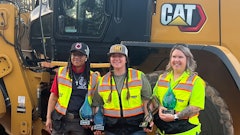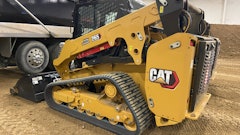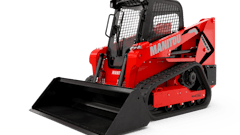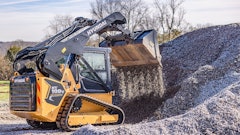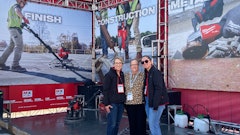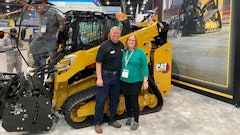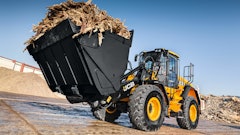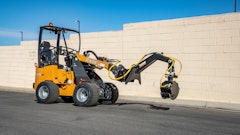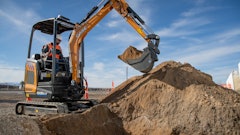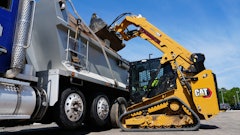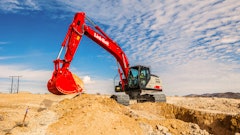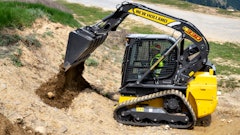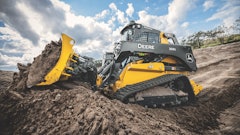
Compact track loaders (CTLs) have earned their well-deserved reputation as a sought-after option in large equipment rentals. They are versatile and easy to use. They also help to expedite different projects. These reliable machines have proven time and again to be indispensable assets on jobsites, offering a host of advantages that go beyond what conventional wheeled equipment can provide.
Before choosing a CTL for a project, some questions need to be answered. The machine’s size, the intended application and the size of the jobsite need to be considered before renting the equipment. This article outlines why CTLs are so popular and provides insights to ensure that the right piece of equipment is rented, no matter what the project entails.
Why CTLs?
To understand why CTLs are so popular, exploring their standout features and benefits is essential. For one, these machines distribute their weight across tracks, resulting in significantly less ground pressure compared to wheeled equipment. This minimizes soil compaction and surface damage, making them suitable for environments like golf courses and residential landscaping.
Additionally, they’re relatively quiet when in use, which is even more beneficial for residential landscaping. The reduced noise will not only be pleasant for those around the jobsite but will make the jobsite safer overall.
CTLs perform well in many environmental conditions, including wet, dry, sandy and snowy terrains, making them useful year-round. Their high productivity stems from the combination of power, versatility and stability, enabling users to complete tasks more efficiently. Most of these machines are equipped with operator friendly cabs, boasting excellent visibility and safety features. This ensures that even team members with limited experience can operate the equipment smoothly and safely while giving jobsite supervisors a little extra peace of mind.
What’s the Application?
The first step when deciding which CTLs to rent is to understand how it is going to be used. What type of material is being moved? What is the terrain like? Both questions can help to inform what piece of equipment is best for the job.
As previously mentioned, CTLs are great for ground maintenance tasks year-round. Their tracks allow them to move better on loose sand or gravel, as well as wet, muddy or snowy terrain. They can grip surfaces much better than their wheeled counterparts. If they are being operated in unpredictable weather conditions, these all-terrain capabilities ensure that the equipment can work effectively regardless of the elements. This enhances the success of the project and demonstrates a commitment to responsible and sustainable construction practices.
From there, it’s also important to consider the project requirements. For applications, contractors must recognize that one size does not fit all. The specific project dictates the appropriate machine size. Questions to answer include: How heavy is the material? Is it a high-volume task?
Each CTL possesses a distinct rated operating capacity (ROC). The ROC indicates how much weight it can handle. Some of the smallest CTLs can carry up to 665 pounds, while some of the largest can hold up to 1,900 pounds. In a few markets, CTLs are available to handle up to 3,200 pounds. Understanding the material weight and volume will guide the selection of CTLs with the right ROC for the project.
What Is the Jobsite Size?
In addition to the application, the size of the jobsite must be considered. Fortunately, CTLs are designed for maneuverability in tight spaces. Their small turning radius allows operators to navigate tight spaces easily. CTLs’ nimbleness and precision enable them to get closer to walls and navigate around protruding objects better than similar pieces of equipment, making them an ideal choice for jobs where every inch counts.
Whether the jobsite is a crowded construction site, a residential backyard or a densely populated urban area, the equipment's capacity to maximize space can significantly impact project timelines and resource allocation. This efficiency translates into cost savings and reduced project completion times, improving overall project management and client satisfaction.
However, one does need to be aware of jobsite access points, such as passageways and entryways to make sure they are large enough to accommodate the equipment. Occasionally, this may entail renting a slightly smaller CTL than initially planned, but it ensures that the work can be completed efficiently. While the size of the different machines offered may only fluctuate a few inches, those few inches could make all the difference in a confined work environment.
Making the Decision
CTLs are a popular choice in heavy equipment rental for many reasons. Because of their versatility, ease of use and efficiency, CTLs provide a smart solution to many jobsite problems. Determining the right loader for a project entails a thorough evaluation of the application, material weight, volume and available workspace.
Environmental considerations, such as the impact on delicate terrain or the ability to handle unpredictable weather, also play a significant role in choosing the right machine. By carefully considering these factors, contractors can confidently select the ideal solution for the specific project, ensuring efficiency, productivity and responsible construction practices.









